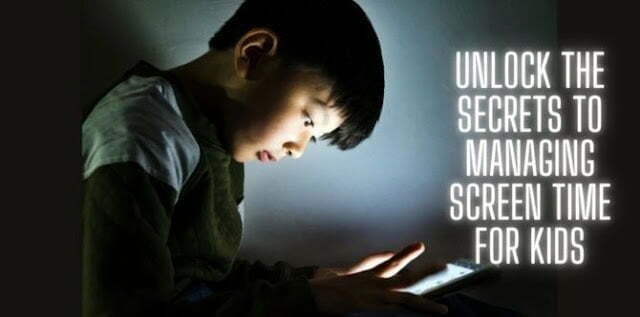In today’s world, technology is everywhere, and it’s hard to escape. It’s no secret that kids are spending more and more time on screens than ever before. From smartphones and tablets to laptops and TVs, screens are a constant presence in their lives. While technology has its benefits, it’s important to manage screen time for kids in the digital age. Here’s why:
Screen time and its impact on children
Let’s start by defining screen time. Screen time refers to the amount of time kids spend using screens, such as smartphones, tablets, computers, TVs, and gaming consoles. Screen time can be either passive or active and can include:
- Watching TV shows or movies
- Playing video games
- Using social media
- Texting or messaging friends
- Using educational apps or programs
Now that we know what screen time is, let’s explore how excessive screen time can affect children. Studies show that too much screen time can have negative effects on children’s physical, mental, and social development. Some of the risks associated with excessive screen time include:
1. Physical Health
Excessive screen time can have a negative impact on children’s physical health. Some of the potential health risks include:
- Obesity: Too much screen time can lead to a sedentary lifestyle, which increases the risk of obesity.
- Sleep problems: Blue light emitted by screens can disrupt the body’s natural sleep cycle, making it harder for kids to fall asleep.
- Vision problems: Excessive screen time can cause eye strain, dry eyes, and other vision problems.
2. Mental Health
Excessive screen time can also have a negative impact on children’s mental health. Some of the potential mental health risks include:
- Anxiety: Spending too much time on screens can increase feelings of anxiety and stress in children.
- Depression: Kids who spend a lot of time on screens may be more likely to experience symptoms of depression.
- Poor self-esteem: Social media use can contribute to low self-esteem and negative body image.
3. Social Development
Finally, excessive screen time can impact children’s social development. Some of the potential social risks include:
- Reduced social skills: Excessive screen time can impact social development and reduce kids’ ability to interact with others in real life.
- Cyberbullying: Kids who use social media are at risk of cyberbullying, which can have a negative impact on mental health and well-being.
- Addiction: Excessive screen time can contribute to addiction and make it harder for kids to engage in other activities.
Given these potential risks, it’s important to manage screen time for kids in the digital age to promote healthy physical, mental, and social development. In the next section, we’ll explore some strategies for establishing screen time rules that work for your family.
Establishing screen time rules
Now that we understand the potential risks associated with excessive screen time, let’s explore how to establish screen time rules that work for your family.
1. Importance of Setting Limits and Boundaries
Setting limits and boundaries for screen time is crucial to promoting healthy physical, mental, and social development in children. Here are some reasons why:
- Limits help prevent overuse and addiction: Setting limits on screen time can prevent children from spending too much time on screens and becoming addicted.
- Boundaries promote balance: Encouraging kids to engage in a variety of activities, both on and off screens, promotes balance and helps prevent physical and mental health risks associated with excessive screen time.
- Limits encourage socialization: Setting limits on screen time can encourage kids to engage in more face-to-face social interactions and develop social skills.
2. How to Establish Screen Time Rules that Work for Your Family
Every family is unique, so there’s no one-size-fits-all approach to establishing screen time rules. Here are some tips for creating rules that work for your family:
- Involve your kids in the process: Consider your children’s age, developmental stage, and interests when establishing rules. Involve them in the process and ask for their input to increase buy-in and cooperation.
- Be specific and clear: Set clear guidelines for how much screen time is allowed each day, what types of content are appropriate, and when screens can be used.
- Set consequences: Establish consequences for breaking the rules, such as loss of screen time or privileges.
- Be consistent: Consistently enforce the rules and consequences to establish a routine and promote adherence.
3. Tips for Enforcing Screen Time Rules and Dealing with Resistance from Kids
Enforcing screen time rules can be challenging, especially when kids resist or push back. Here are some tips for dealing with resistance:
- Be firm and consistent: Stick to the rules and consequences, even when your child resists or protests.
- Offer alternatives: Encourage your child to engage in alternative activities, such as outdoor play, reading, or art projects, to promote balance and reduce screen time.
- Use positive reinforcement: Praise your child for following the rules and sticking to screen time limits.
- Model healthy screen time behavior: As a parent or caregiver, model healthy screen time behavior by limiting your own screen time and engaging in other activities with your child.
By following these tips, you can establish screen time rules that work for your family and promote healthy physical, mental, and social development for your children in the digital age.
Alternatives to screen time
In the digital age, it’s important to find alternatives to screen time to help children develop their creativity, social skills, and physical health.
Benefits of Engaging Children in Non-Screen Activities
- Encourages creativity and imagination
- Builds social skills and fosters relationships
- Improves physical health and fitness
- Reduces stress and anxiety
- Helps children develop problem-solving and critical thinking skills
Examples of Alternative Activities to Replace Screen Time
- Outdoor play: Encourage your child to spend time outside, playing with friends, or exploring nature. This can include anything from playing catch or hide-and-seek to going on a hike or bike ride.
- Arts and crafts: Set up a designated area in your home where your child can get creative with art supplies, such as paints, markers, or clay.
- Board games: Choose age-appropriate board games that can be played with family members or friends. This helps children develop social skills and strategic thinking.
- Reading: Encourage your child to read books that are age-appropriate and of interest to them. Reading helps improve language skills and imagination.
- Cooking: Involve your child in meal preparation by allowing them to help with simple tasks like measuring ingredients or stirring.
- Sports and fitness activities: Encourage your child to participate in sports or other physical activities that interest them, such as swimming, dancing, or martial arts. This helps promote physical fitness and a healthy lifestyle.
By providing alternatives to screen time, you can help your child develop new skills, improve their physical health, and reduce their dependence on digital devices. Remember to lead by example and participate in these activities with your child to create positive and lasting memories together.
Tips for managing screen time outside the home
Screen time can be particularly challenging to manage when your children are away from home, visiting friends, or traveling with family. Here are some tips to help you manage screen time outside the home:
Guidelines for screen time when visiting friends or family
- Talk to the hosting parents or family members about their screen time rules and expectations. Ask if they have any concerns or preferences about how much screen time your child is allowed.
- Bring alternative activities such as books, board games, or outdoor toys that your child can enjoy instead of screen time.
- Set clear boundaries and expectations with your child before the visit, and make sure they understand the rules and consequences for breaking them.
- Consider limiting screen time during visits to allow your child to focus on socializing and building relationships with friends and family.
How to manage screen time during travel and vacations
- Plan ahead by bringing alternative activities for your child to enjoy during travel time, such as coloring books, puzzles, or audio books.
- Set limits on screen time during travel, such as allowing one movie or TV show per travel day.
- Take advantage of opportunities to engage in outdoor activities or explore new places, which can be more stimulating and engaging than screen time.
- If you are staying in a hotel or rental property, consider setting up a designated screen time area or time of day to allow your child to enjoy screen time without it taking over the entire vacation.
By following these tips, you can help your child manage their screen time outside the home and create a balanced and healthy relationship with technology.
Conclusion
Managing screen time for kids in the digital age is essential for their overall well-being and development. As a parent, you play a crucial role in helping your child strike a healthy balance between screen time and other activities.
To recap, here are some key takeaways on managing screen time for kids in the digital age:
- Screen time includes all forms of digital media, such as TV, video games, smartphones, tablets, and computers.
- Excessive screen time can have negative effects on children’s physical, mental, and social development.
- It’s important to establish screen time rules and limits that work for your family, and to enforce them consistently.
- Encouraging your child to engage in non-screen activities can have numerous benefits, including promoting creativity, social skills, and physical activity.
- When managing screen time outside the home, it’s important to set guidelines and expectations with friends and family, and to plan ahead for travel and vacations.
In conclusion, managing screen time for kids in the digital age requires a proactive approach and ongoing effort. By setting clear rules, promoting alternative activities, and being mindful of screen time during travel and visits, you can help your child develop healthy screen habits and thrive in the digital age.












